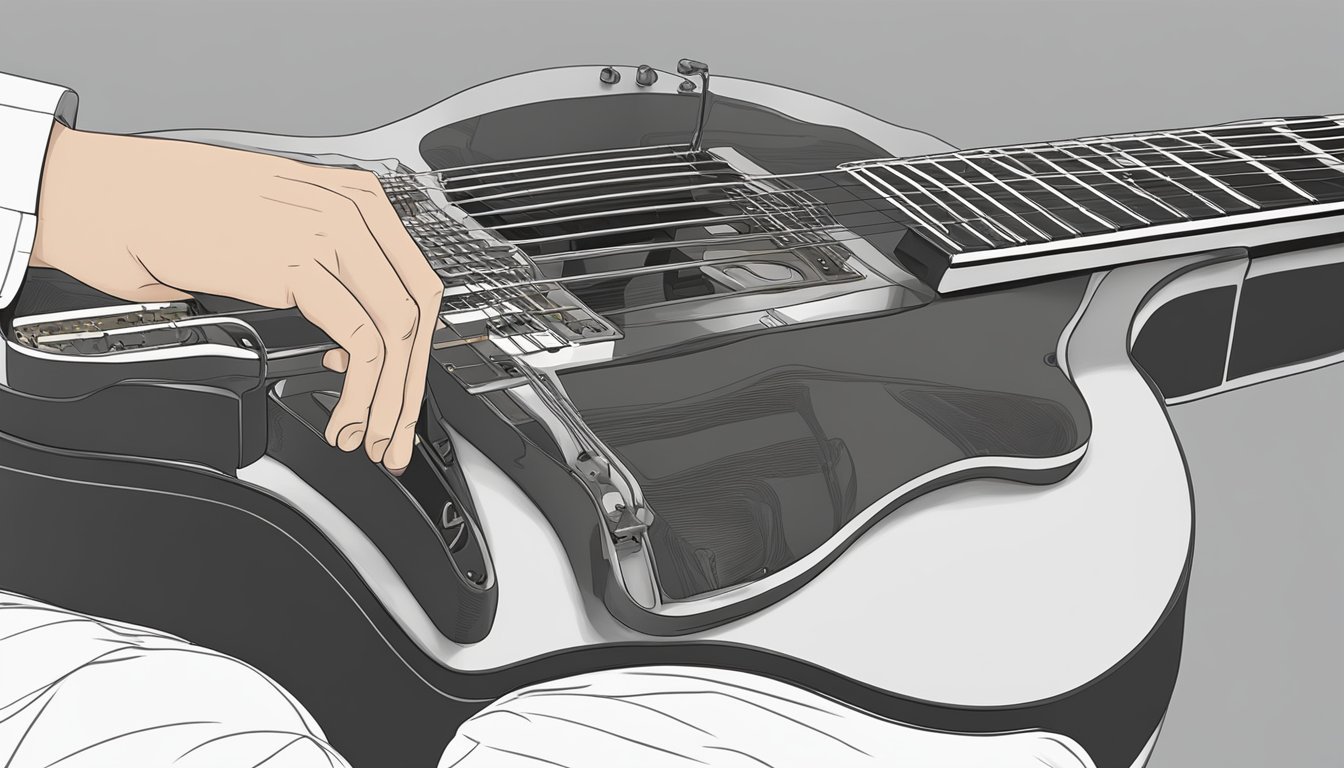Changing the strings on your electric guitar is an essential skill that every guitarist should learn.
Doing it correctly not only improves your sound but also helps keep your instrument in good condition.
With a few simple tools and some tips, you can change your strings quickly and easily.

In this guide, you’ll discover how to prepare your workspace, remove the old strings, and install fresh ones.
You’ll also pick up some handy tuning and maintenance tips to ensure your guitar always sounds its best.
Whether you’re a beginner or just need a quick refresher, this article will help you make string changing a breeze.
Key Takeaways
- Prepare your workspace and gather the right tools for a smooth string change.
- Learn proper techniques for removing and installing guitar strings safely.
- Keep your guitar in tune and maintain it regularly for the best performance.
Preparing Your Workspace and Tools

Getting your workspace ready is an important step before changing your guitar strings.
Having the right tools and a tidy area will make the process smoother and more enjoyable.
Gathering the Right Tools
First, make sure you have all the necessary tools on hand.
Here’s a quick list to help you out:
- New guitar strings: Choose the gauge that matches your playing style.
- Tuner: You’ll need this for accurate tuning after you change the strings.
- String winder: This tool speeds up the winding process.
- Wire cutters: Use these to snip off any excess string length.
Having these tools ready will save you time and frustration.
Visit a local music store if you need any replacements.
Stock up, and don’t hesitate to ask for help if you’re unsure about what you need.
Setting Up Your Work Area
Creating a clean and organized workspace is next.
Find a flat surface where you can comfortably work.
A table or desk is ideal.
Lay down a soft cloth to protect your guitar’s finish and prevent small parts from getting lost.
Make sure you have good lighting to see what you’re doing.
Arrange your tools close by, so you don’t need to reach too far while changing strings.
Keep your tuner, string winder, and wire cutters within easy reach.
This setup helps keep everything running smoothly as you work.
Removing Old Strings
Changing guitar strings starts with safely removing the old ones.
You’ll need to loosen the tension on the strings first, then unwind them, and finally cut them away without damaging your guitar.
Here’s how to do it step by step.
Loosening the Tension
Before you can take off the old strings, you need to loosen them.
You can do this by turning the tuning pegs on the headstock.
Turn each peg slowly in the opposite direction to which the string was wound.
Make sure to loosen each string enough so they are no longer taut.
This will make it easier to remove them.
Loosening the tension also prevents stress on the guitar neck, which can affect the tuning post and other components.
If you’re feeling unsure, just take your time.
It’s better to be cautious than to rush and risk damage.
Unwinding the Strings
Once the tension is released, it’s time to unwind the strings.
Start at the top and work your way down.
Grab the string close to the tuning peg and carefully turn it counterclockwise.
Let the string unwind gently.
Be mindful that the string can spring back if it’s under any tension.
If you are changing all the strings, you can loosen one at a time and remove them from their tuning pegs.
Take care to keep track of where each string goes so you know how to put the new ones on.
Cutting the Strings Safely
Now that the strings are unwound, you can cut them safely.
Use a pair of string cutters or wire cutters to snip the string at the midpoint or near the bridge.
Make sure to wear eye protection if cutting the strings—sometimes they can snap.
After cutting, you can easily pull the loose parts of the string out from the tuning pegs and bridge.
Dispose of the old strings properly to keep your space clean.
With the old strings out of the way, you’re ready to move on to putting on the new ones!
Installing New Strings
When changing your electric guitar strings, it’s important to secure them properly to the bridge and tune them correctly.
This ensures better tuning stability and makes your guitar sound its best.
Let’s go through the steps.
Securing Strings to the Bridge
Start by threading the string through the bridge if your guitar has a string-through design.
This means the strings will go directly through the body of the guitar.
If your guitar uses bridge pins, insert the string into the pin securely.
Make sure the string sits firmly in the groove to prevent slippage.
When you pull the string tight, do it with enough pressure, so it stays in place.
You want to avoid any uneven tension as you continue to install the rest of the strings.
Winding Strings around the Tuning Pegs
Once the strings are secured at the bridge, it’s time to wind them around the tuning pegs.
Begin by inserting the string into the tuning machine’s hole and leave a bit of slack.
This slack will allow for proper winding.
Make sure to wind the strings neatly in the same direction, usually clockwise.
Aim for about three to four turns for each string to maintain tuning stability.
Avoid crossing the strings as you wind; instead, keep them layered neatly on the peg.
This will help prevent them from slipping or getting tangled.
Stretching the Strings
After you’ve installed all the strings, stretching them is key for tuning stability.
Gently pull each string away from the fretboard, but be careful not to pull too hard.
Use just enough pressure to stretch out the slack.
This step helps the strings settle into their tuning more quickly.
After stretching, retune your guitar and repeat the stretching if necessary.
This process will ensure that your new strings stay in tune longer and sound great while you play.
Tuning and Maintenance Tips
Getting your guitar in tune and keeping it that way is key to a great sound.
Regular maintenance after string changes can enhance the performance of your instrument.
Here’s how to achieve stable tuning and care for your guitar after you’ve restrung it.
Achieving Stable Tuning
To achieve stable tuning after changing your strings, use a reliable guitar tuner.
Clip-on tuners are great for quick adjustments, while pedal tuners work well during gigs.
After installing new strings, stretch them gently to help them settle.
You can do this by pulling the string upward, but don’t yank too hard.
Make sure to tune your guitar multiple times after restringing.
- Tune to pitch: Start with the low E string and go up to high E.
- Re-check tuning: Play some chords and see if the pitch holds.
- Keep an eye on stability: If tuning slips, consider having a guitar tech check your nut and tuning pegs.
Caring for Your Guitar Post-Stringing
Once your new strings are on, give your guitar some love.
Wipe down the strings with a soft cloth to remove any residue from your hands.
This can help prolong string life and keep them sounding bright.
Don’t forget the fretboard! Use lemon oil or a specialized cleaner to keep it in good shape.
If you gig often, consider getting a guitar tech to look over your instrument regularly.
Check your stability by ensuring that the guitar is properly set up.
This includes checking the truss rod and action height.
A little maintenance goes a long way, so take the time to care for your guitar after each restringing session.
Frequently Asked Questions
Restringing your electric guitar can seem tricky at first, but it’s pretty manageable once you know what to do.
Let’s dive into some common questions that come up when changing strings.
One of the most frequently asked questions is how to change guitar strings effectively without causing any damage to the guitar.
It’s important to familiarize yourself with the different types of strings available and the tools you’ll need for the job.
With the right approach, you’ll not only have fresh strings on your guitar but also gain confidence in your ability to maintain your instrument.
What do I need to know before restringing an electric guitar for the first time?
Before you start, gather some tools like wire cutters and a string winder.
Make sure you have the right type of strings for your guitar.
Also, check if you need to do any cleaning while you’ve got the strings off.
Can I replace the strings on my electric guitar on my own, or should I get professional help?
You can definitely change the strings on your own! It’s a straightforward process that many players handle without any issues.
Just take your time, and follow the steps, and you’ll be fine.
What’s the easiest way to change strings on a Stratocaster?
For a Stratocaster, first, loosen the old strings by turning the tuning pegs.
Then, remove them from the bridge and pull them out of the tuning pegs.
Thread the new strings through the bridge and tuning pegs, leaving some slack for winding.
Are there any tips for changing strings on an electric guitar without using special tools?
Yes, you don’t need any special tools if you’re careful.
Use your hands to loosen and remove the strings, and you can wind them by hand as well.
Just make sure to keep everything neat to avoid tangles.
How often should I replace the strings on my electric guitar to keep it sounding great?
It’s a good idea to change your strings every 1 to 2 weeks if you play regularly.
If you notice they feel rough or are losing their tone, it’s probably time for a fresh set.
How to Properly Change the Strings on a Les Paul Electric Guitar
Start by loosening and removing the old strings.
Then, clean the fretboard while the strings are off.
After that, insert the new strings through the back of the body or the tuning pegs.
Pull them taut, and wind them securely, making sure they sit correctly on the tuning posts.

